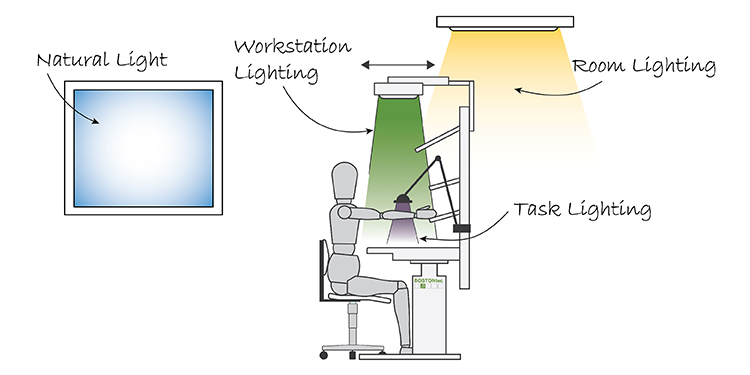Proper illumination, which is the adequate and effective provision of light in a workspace, particularly enhances productivity. From office environments to manufacturing facilities and homes, lighting quality can profoundly impact individuals’ performance, mood, and well-being. We will delve into the relationship between proper illumination and productivity, exploring how diverse aspects of lighting, such as intensity, color temperature, and glare control, can influence human performance and efficiency. Simple Lighting’s premium LED tape lights offer energy efficiency and a wide range of customizable options, making them the perfect choice for any modern lighting project.
The Importance of Proper Illumination
Proper illumination is a fundamental aspect of a well-designed workspace. It goes beyond aesthetics and extends to individuals’ physiological and psychological well-being. One of the most immediate effects of inadequate lighting is eye strain, which can usher discomfort and decrease productivity. Additionally, poor lighting can contribute to headaches, fatigue, and a general sense of unease. Conversely, well-designed lighting can lessen these negative effects and create a more conducive environment for work.
The Role of Lighting Intensity
Lighting intensity, measured in lux (lumens per square meter), is critical in determining how effectively a space is illuminated. The appropriate level of illumination varies depending on the task at hand. For example, tasks that require precision and attention to detail, such as reading fine print or assembling small components, demand higher light intensities. In distinction, areas designated for relaxation or social interaction may benefit from lower light levels to create a comfortable ambiance.
Insufficient lighting intensity can result in reduced visibility and strained eyes, leading to decreased productivity. It may also necessitate squinting or leaning closer to work surfaces, contributing to physical discomfort and long-term health issues. Adequate illumination, on the other hand, allows individuals to work comfortably and efficiently, minimizing the risk of eye strain and related problems.
The Impact of Color Temperature
The color temperature of light, typically measured in Kelvin (K), refers to the warmth or coolness of light. Lower color temperatures, around 2700-3000K, produce warm, yellowish light resembling the color of incandescent bulbs. In contrast, higher color temperatures, such as 5000K or more, create cooler, bluish-white light akin to daylight. The choice of color temperature can have a profound effect on productivity.
Research has shown that cooler light with higher color temperatures can enhance alertness and focus, making it particularly suitable for tasks requiring concentration, such as reading, writing, or data analysis. Warmer light, on the other hand, tends to assemble a more relaxed and comfortable atmosphere, making it suitable for areas where creativity or social interaction is encouraged. Properly balancing color temperatures within a workspace can help individuals transition between tasks more effectively, enhancing overall productivity.
Controlling Glare for Productivity
Glare, the excessive and uncontrolled brightness in a visual field, can be a paramount hindrance to productivity. Glare can be yielded by direct sunlight, reflected light from surfaces, or even poorly positioned light fixtures. Glare can usher to discomfort, reduced visual acuity, and a greater risk of accidents.
Controlling glare through proper lighting design is crucial for enhancing productivity. This can be achieved by using shading devices, such as blinds or curtains, to obstruct direct sunlight. Additionally, anti-glare coatings on computer screens and the strategic placement of light fixtures can minimize glare-related issues. By eliminating or reducing glare, a workspace becomes more comfortable and conducive to tasks that mandate extended periods of visual concentration.
The Influence of Lighting on Circadian Rhythms
Proper illumination can also support the alignment of an individual’s circadian rhythms, the internal biological clock that regulates sleep-wake cycles. Natural light, which varies in intensity and color temperature throughout the day, helps to synchronize these rhythms. When individuals are exposed to sufficient natural light during the day and experience darkness at night, their circadian rhythms are more likely to remain in sync. Disruptions to circadian rhythms, often caused by insufficient exposure to natural light, can result in sleep disturbances and mood disorders, negatively impacting productivity. Employers and designers can use lighting strategies such as tunable LED systems to mimic the natural progression of light throughout the day, promoting better sleep and overall well-being among workers.
Proper illumination enhances productivity across various settings, from offices and classrooms to manufacturing facilities and homes. Lighting intensity, color temperature, glare control, and the psychological impact of lighting all play paramount roles in influencing human performance and well-being. Research and case studies consistently demonstrate that well-designed lighting can increase productivity, mood, and job satisfaction. As we continue to recognize the importance of lighting in our daily lives, it is paramount for individuals, organizations, and designers to prioritize proper illumination in their spaces.




